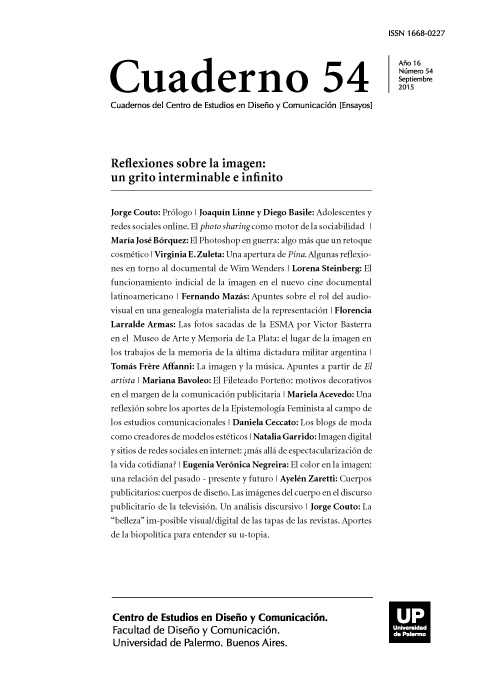Una apertura de Pina. Algunas reflexiones en torno al documental de Wim Wenders
Abstract
This article presents the analyse of the film Pina (2011) by Wim Wenders. The
documentary is about the history of the dancer Pina Bausch, more precisely, the story of
Pina as director and choreographer of the Tanztheater Wuppertal. Filmed in urban and
natural scenery of the German -Wuppertal city, home of the company, and with the help
of 3D technology, the film is composed of fragments of works, memoirs, and pictures.
As a starting point the article approaches the notion of film-esay and its link to the biographical documentary. It also describes some aspects of the film that we believe could match
with this non-gender- called film-esay. We work with the images of the film not as representations of reality, but as producers ones; images not only produce the world but they
produce ourselves. In this sense, the “we” that accompanies the verb “produce” challenges
us, as subjectivity. And we wonder what would happen with Pina without these images
that make possibe to think about her?. Is it possible to think about her as something independent of the images production? We believe that questionning about the biographical
implies to pose a quiestion about subjectivity and their modes of production. From these
problems, we approach the in-and-out theater space to think the dance theater space and
the dancer’s body as an actor and producer.
References
Amado, A. (2009). La imagen justa. Cine argentino y política (1980-2007). Buenos Aires: Ed. Colihue.
Bentivoglio, L. (1991). Dialogando con Pina Bausch en El Público, nº 87-Noviembre/Diciembre 1991, Madrid: Centro de Documentación Teatral-INAEM.
Blümlinger, C. (2007). Leer entre las imágenes en La forma que piensa. Tentativas en torno al cine-ensayo. Navarra: Fondo de publicación del Gobierno de Navarra, pp. 50-63.
Defert, D. (2010). “Heterotopía”: Tribulaciones de un concepto entre Venecia, Berlín y los Ángeles en El cuerpo utópico. Las heterotopías. Buenos Aires: Ed. Nueva Visión, pp. 33-62.
Deleuze, G. (2009). Crítica y clínica. Barcelona: Anagrama.
Gainza, M. (2011, 08 de octubre). Bailando en la dimensión desconocida en Página 12, Radar. Recuperado de http://www.pagina12.com.ar/diario/suplementos/radar/9-7374-2011-10-10.html
Foucault, M. (2010). El cuerpo utópico. Las heterotopías. Buenos Aires: Ed. Nueva Visión.
(1988) “El sujeto y el poder” en Revista Mexicana de Sociología, Vol. 50, N° 3, julio-setiembre, pp. 3-30.
(1968). Las palabras y las cosas. Una arqueología de las ciencias humanas. Buenos Aires: Siglo XXI.
Nietzsche, F. (2007). Más allá del bien y del mal. Buenos Aires: Alianza.
Rioseco, C. (2012). El cine 3D. Su impresión, el desengaño y la excepción en Revista La Fuga. Recuperado de: http://www.lafuga.cl/
Stiletano, M. (30 de febrero de 2011). Pina: la danza según Wim Wenders. La Nacion. Recuperado de: http://www.lanacion.com.ar/1411529-pina
Ulm, H. (2011). Cuestión de imágenes: charlas de artes y filosofía, Salta. Ediciones de la Galería el Fedro.
Weinrichter, A. (2007). Un concepto fugitivo. Notas sobre el film-ensayo en La forma que piensa. Tentativas en torno al cine-ensayo. Navarra: Fondo de publicación del Gobierno de Navarra, pp. 18-48.
Filmografía
Wenders, W. (2011). Pina. Alemania-Francia-Inglaterra.
Los autores/as que publiquen en esta revista ceden los derechos de autor y de publicación a "Cuadernos del Centro de Estudios de Diseño y Comunicación", Aceptando el registro de su trabajo bajo una licencia de atribución de Creative Commons, que permite a terceros utilizar lo publicado siempre que de el crédito pertinente a los autores y a esta revista.


